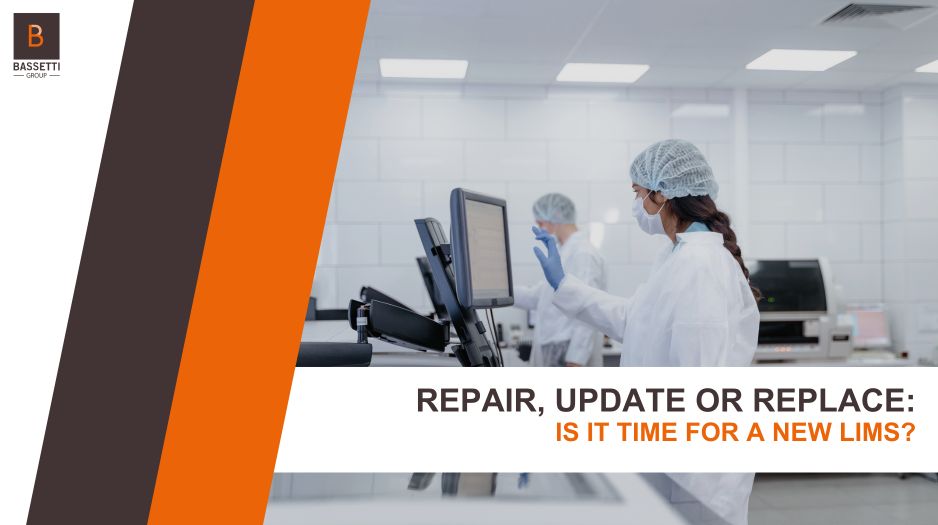Repair, Update, or Replace: is it time for a new lims?
As laboratories continuously grow and evolve, a crucial question arises for every lab manager: Is our current Laboratory Information Management System (LIMS) still serving our needs effectively? If not, the decision to repair, update, or completely replace your LIMS can feel daunting, but making an informed choice is key for maintaining efficiency, ensuring compliance, and supporting future growth. This guide will walk you through the key considerations for such a decision, helping you determine the best path forward for your lab.

When to Repair Your LIMS
Sometimes, your LIMS software isn’t fundamentally broken, it’s just experiencing a few minor hiccups.
- Minor Glitches and Bugs: If your system is encountering occasional errors, slowdowns, or isolated functionalities are not working as expected, a simple repair might be all that’s needed. These are often addressable with minor configuration adjustments and software bug fixes and patches.
- Performance Optimization Needs: When your LIMS is running slower than desired but is otherwise functional, optimizing its performance can breathe new life into it. This could involve database indexing, server upgrades, or fine-tuning existing settings.
- Small Configuration Changes or Tweaks: Perhaps a new workflow requires a slight adjustment to how data is entered or processed. Small, targeted configuration changes can often resolve these issues without significant disruption.
- Cost-Effectiveness: For localized problems, the cost and effort of a repair are typically far less than a major update or, especially, a full replacement.
When to Update Your LIMS
An update signifies a more significant change, often involving new versions of your existing LIMS software. This is usually driven by a need for enhanced capabilities or improved system health.
- New Software Versions or Patches Available: Software vendors regularly release updates that include bug fixes, security enhancements, and new features. Staying current with these updates is crucial for system stability and security.
- Need for New Features or Functionalities: If your lab’s needs have evolved and your current LIMS version lacks specific features that would significantly improve efficiency (e.g., enhanced instrument integration, new reporting capabilities), an update is often the answer.
- Integration with Other Systems: As your lab grows, you might need your LIMS to seamlessly communicate with other software like ERP systems, instrument control software, or a LIMS tool like an electronic lab notebook (ELN). Updates often introduce or improve these integration capabilities.
- Compliance with New Regulations or Standards: Regulatory bodies frequently update guidelines. A LIMS update can ensure your system remains compliant with the latest industry standards and certifications.
Scalability Challenges with Current Version: If your lab’s sample volume or user base has grown significantly, an older version of your LIMS might struggle to keep up. An update can address scalability limitations and prepare your system for future expansion.
When to Replace Your LIMS Entirely
A complete LIMS software replacement is the most drastic, but sometimes necessary, step. This is typically considered when your existing system has become a significant impediment to your lab’s operations and strategic goals.
- Legacy System Limitations: If your LIMS is built on outdated technology, is no longer supported by its vendor, or is incompatible with modern hardware and software, it’s a strong candidate for replacement. Legacy systems often present security risks and are difficult to maintain.
- Fundamental Shift in Business Needs or Processes: If your lab has undergone a major transformation in its core operations, research focus, or service offerings, your old LIMS might simply not be designed to support the new paradigm.
- Excessive Repair Costs or Frequent Issues: When you’re constantly pouring resources into fixing recurring problems, and the cost of maintenance approaches that of a new system, replacement becomes a more economically sound decision.
- Lack of Scalability for Future Growth: If your lab anticipates significant expansion in terms of samples, tests, or personnel, and your current LIMS cannot realistically handle that growth, a new, scalable software solution is essential.
- Poor User Adoption or Inefficient Workflows: A LIMS that is cumbersome, difficult to use, or forces inefficient workflows can be a major source of frustration for lab personnel, leading to errors and decreased productivity.
- Security Vulnerabilities and Risks: In an era of increasing cyber threats, an outdated or insecure LIMS can put your sensitive lab data at serious risk. A new system with robust security features is paramount.
Key Considerations for Your Decision
Regardless of whether you lean towards repairing, updating, or replacing, several critical factors should guide your decision-making process:
- Cost Analysis: Look beyond the initial investment. Consider ongoing maintenance, support contracts, training costs, and the potential costs of downtime during implementation.
- Time Commitment: How much time will the process take? A repair might be quick, an update could involve some downtime, and a replacement will require significant planning and implementation time.
- Impact on Operations and Users: How will the change affect daily lab operations? Will there be significant disruption? How will users adapt to new interfaces or workflows?
- Future-Proofing and Long-Term Strategy: Does your chosen LIMS technology position your lab for future growth and technological advancements? Will it meet your needs for the next 5-10 years?
- Vendor Support and Ecosystem: Assess the reliability and responsiveness of your current or potential LIMS software. A strong support system is invaluable.
The Decision-Making Process
To make an informed decision, follow a structured approach:
- Assess Current LIMS Performance and Pain Points: Document specific issues, inefficiencies, and limitations of your existing system. Gather feedback from all users.
- Define Current and Future Needs: Clearly articulate what your LIMS must do now and what you anticipate needing it to do in the coming years.
- Evaluate Available Options: Research potential updates from your current vendor or explore new LIMS solutions on the market if replacement seems likely.
- Conduct a Thorough Cost-Benefit Analysis: Quantify the potential benefits (e.g., increased efficiency, reduced errors) against the costs for each option.
- Engage Stakeholders: Involve lab managers, IT personnel, and end-users in the decision-making process to ensure buy-in and a solution that meets everyone’s needs.
The decision to repair, update, or replace your LIMS is a significant one that impacts the efficiency, compliance, and future success of your laboratory. By carefully assessing your current situation, understanding the implications of each option, and considering your long-term strategic goals, you can make an informed choice that propels your lab forward. A well-chosen LIMS is an invaluable asset, ensuring your lab operates at its peak potential.
TEEXMA for LIMS: A Solution for Modern Labs
When considering a LIMS replacement or a significant update, TEEXMA for LIMS emerges as a robust and adaptable option. Developed by the Bassetti Group, TEEXMA for LIMS is a Laboratory Information Management System designed to centralize and optimize laboratory activities across various industries, including R&D and quality control.
Key Features and Capabilities
- Automation of Laboratory Processes: It automates tasks such as sample registration, test planning, and report generation, significantly reducing manual effort and the risk of human error. This streamlining of workflows is critical for improving efficiency and productivity.
- Centralized Data Management: The system centralizes all laboratory data, from test requests and samples to experimental results and reports. This ensures easy access to essential information, facilitates data comparison and statistical analysis, and promotes digital continuity.
- Traceability and Regulatory Compliance: TEEXMA for LIMS guarantees complete traceability of samples at every stage and helps labs comply with stringent regulatory requirements such as ISO 17025, FDA 21 CFR Part 11, and GLP. It provides features like audit trails and electronic signatures to support validation processes.
- Efficient Inventory and Equipment Management: Our LIMS solution includes tools for managing consumables, reagents, and laboratory equipment. It can help monitor instrument status, schedule calibrations and maintenance, and track stock levels, ensuring resources are available and operational.
- Integration Capabilities: TEEXMA for LIMS is designed for interoperability, seamlessly integrating with other enterprise systems like ERP, MES, and CRM, as well as various laboratory instruments. This eliminates data silos and promotes a unified information flow across the organization. Its modular and no-code/low-code design allows for easy creation of automated workflows and custom integrations.
- Customizable and Scalable: The software is modular and highly customizable, allowing laboratories to configure it to their specific workflows and needs without extensive development. It supports multi-site structures with centralized data and site-specific access rights, making it suitable for growing organizations.
- Reporting and Analysis: TEEXMA for LIMS provides interactive dashboards, customizable reports, and advanced data visualization tools to offer real-time insights into lab operations and performance. This supports strategic decision-making and the generation of Key Performance Indicators (KPIs).
Benefits for Modern Laboratories
- Increased Productivity and Efficiency: By automating repetitive tasks and streamlining workflows, the system helps labs achieve higher throughput and faster turnaround times.
- Enhanced Data Quality and Reliability: Automation and standardized protocols reduce manual errors, leading to more accurate and reproducible results.
- Simplified Compliance and Risk Reduction: Robust traceability, audit trails, and features supporting regulatory standards minimize compliance risks and facilitate audits.
- Improved Collaboration and Knowledge Management: Centralized data and secure sharing capabilities foster better collaboration among lab personnel and allow for the capitalization of technical expertise.
- Future-Proofing: Its flexible, modular, and scalable architecture ensures that the system can evolve with the lab’s changing needs and adapt to future technological advancements.
Considering TEEXMA for LIMS when evaluating a LIMS update or replacement means looking at a solution that emphasizes automation, compliance, and adaptability, crucial elements for any modern laboratory striving for peak performance.
